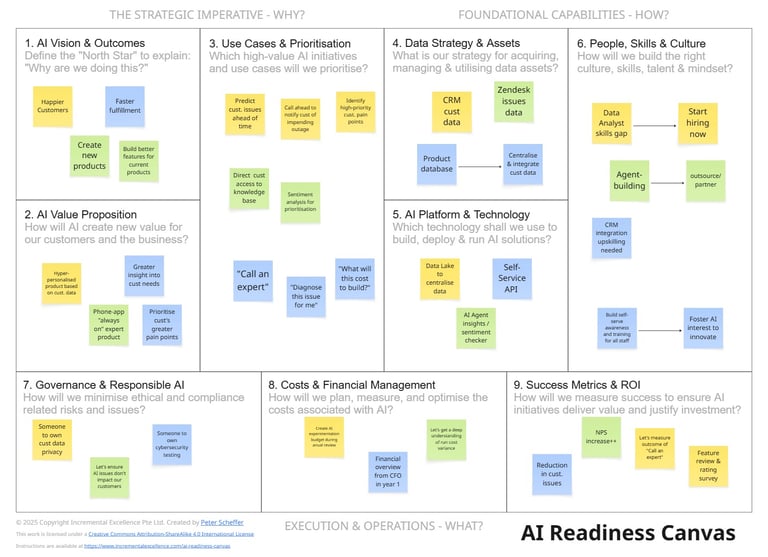The AI Readiness Canvas
The AI Readiness Canvas helps organisations to create a clear strategy and direction for the company to adopt AI. It highlights the gaps, the drivers, the need and the purpose for adopting AI.
The Canvas is designed as a template so that people can produce multiple copies and iterate on them to explore options and opportunities before settling on an agreed approach.
The Canvas is modelled on similar Canvases such as the Business Model Canvas so that it is familiar and easy to use.
Page contents:
Introducing the AI Readiness Canvas
Section 1: AI Vision & Business Outcomes
Section 2: AI Value Proposition
Section 3: Key Use Cases & Prioritisation
Section 4: Data Strategy & Assets
Section 5: AI Platform & Technology Stack
Section 6: People, Skills & Culture
Section 7: Governance & Responsible AI
Section 8: Cost Structure & Financial Management
Section 9: Success Metrics & ROI
Framework for AI Adoption - The 6 Perspectives
6 Organisation Capabilities Enhanced by AI:
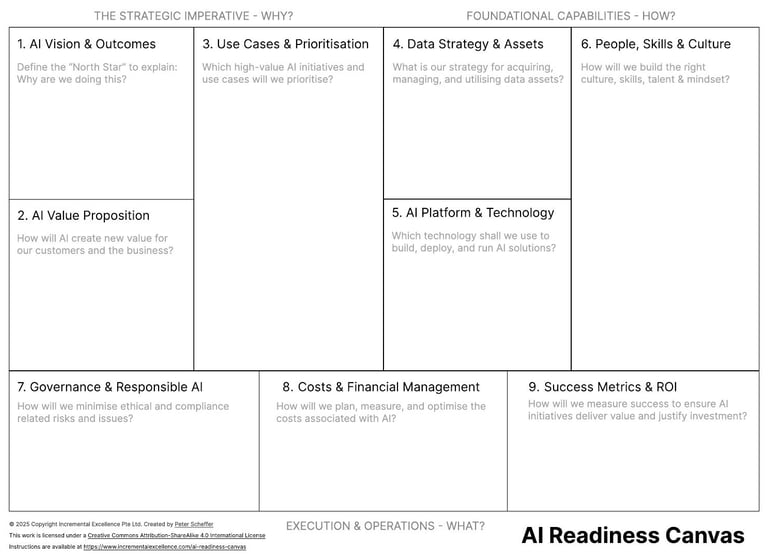

Date published: October 2, 2025
The canvas is a single-page visual template, similar to the Business Model Canvas. It is designed for repeated use, allowing teams to iterate on ideas, discuss options, and align on a strategic approach. It is divided into distinct blocks or sections, each posing critical questions that guide the user's thinking about AI adoption and strategy. The goal is to move from early exploration to delivering measurable value as quicklty as possible.
The Canvas is structured around three core areas; Strategy, Foundations, and Execution seen in various popular adoption frameworks:
1. Why? (The Strategic Imperative):
Focuses on the business vision and value proposition. This part of the canvas helps teams to "work backwards" from their desired business outcomes to define a clear purpose for AI adoption.
Covered by Canvas Sections 1, 2 & 3.
2. How? (The Foundational Capabilities):
List out the needed resources, skills, and culture to implement the business vision. Decide which capabilities need to be developed to enable a robust AI organisation, covering data, technology and people.
Covered by Canvas Sections 4, 5 & 6.
3. What? (The Execution & Operations):
Describe the implementation, including governance, managing costs, and how to define success. This area covers the essential building blocks that ensures the organisation will succeed with its implementation.
Covered by Canvas Sections 7, 8 & 9.
Introducing the AI Readiness Canvas
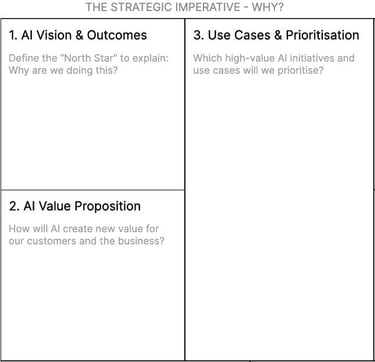

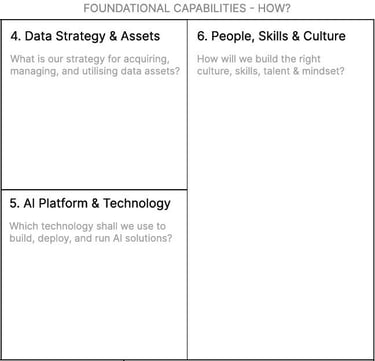



Section 1: AI Vision & Business Outcomes
Purpose: To define the "north-star" for AI adoption, ensuring it is tied to tangible business impact. It answers the question "Why are we doing this?"
Key Questions to ask:
What are our primary business objectives for adopting AI (e.g., reduce costs, grow revenue, create new products, improve customer experience, increase efficiency)?
What is our long-term vision for becoming an AI-driven organisation?
How will AI create a competitive advantage or help us respond to market shifts?
What transformational opportunities can AI unlock (e.g., new business models, new markets)?
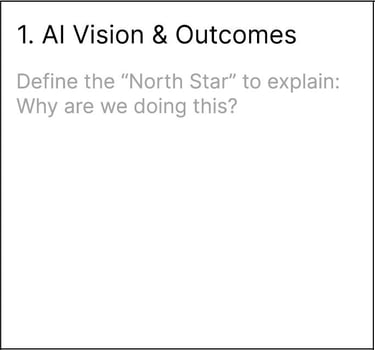

Section 2: AI Value Proposition
Purpose: This section, similar to its counterpart in the Business Model Canvas, focuses on how AI will create new value for customers and the business.
Key Questions to ask:
What compelling new products, services, or features can we offer by infusing them with AI?
How can we use AI to create hyper-personalised experiences for our customers at scale?
How will we use AI to uniquely solve customer problems or fulfill their needs?
How can we differentiate ourselves in the market through improved value creation?
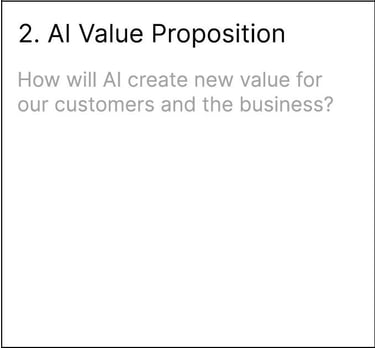

Section 3: Key Use Cases & Prioritisation
Purpose: To identify and prioritise a portfolio of specific, high-value AI initiatives that are feasible to implement.
Key Questions to ask:
What are the top 3 - 5 business problems we want to solve with AI right now?
How will we prioritise these use cases based on business impact, feasibility, and time-to-value?
Which use cases can provide quick wins to build momentum, and which are long-term strategic bets?
What are the top AI use cases in our industry (e.g., predictive maintenance, fraud detection, conversational AI, content creation, process automation, report generation)?
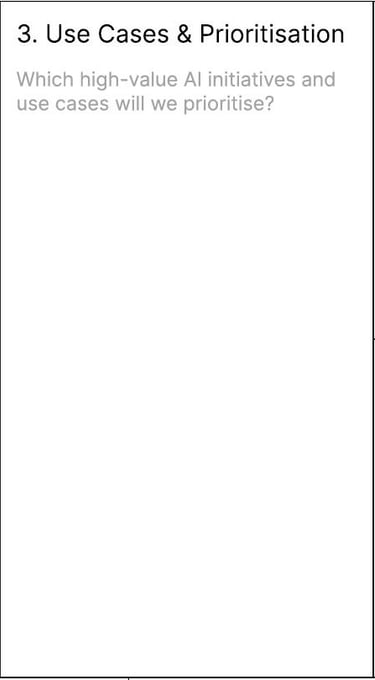

Section 4: Data Strategy & Assets
Purpose: Data is the "genesis of invention" for AI. This section focuses on the strategy for acquiring, managing, and leveraging data as a core business asset.
Key Questions to ask:
What internal and external data sources do we need for our prioritised use cases?
What is needed to make our data "usable"?
How will we ensure data quality, accessibility, and governance (e.g., data lakes, APis, catalogues, data ownership)?
How will we build an "AI flywheel" where our products generate new data that improves the AI, which in turn improves the product?
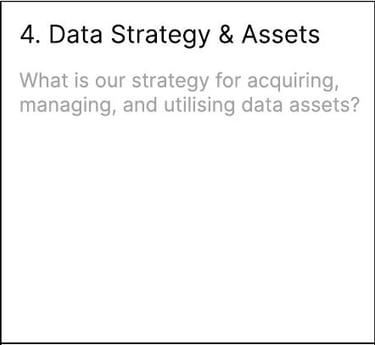

Section 5: AI Platform & Technology Stack
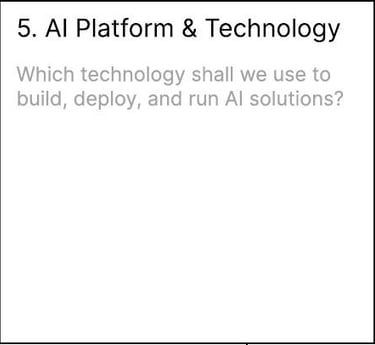

Purpose: To define the scalable, enterprise-grade technology platform needed to build, deploy, and operate AI solutions.
Key Questions to ask:
What will our AI technology stack look like (e.g., cloud services, data hosting, specialised hardware, vendor solutions)?
What is our Build vs. Buy vs. Partner strategy for AI models and solutions?
How will we manage the AI lifecycle from experimentation to production?
Will we use a centralised platform, a hybrid "hub-and-spoke" model, or a decentralised approach?
Section 6: People, Skills & Culture


Purpose: Successful AI adoption is critically dependent on people. This section addresses talent, upskilling, and the necessary cultural mindset.
Key Questions to ask:
What AI talent and roles do we need to hire, train, or outsource (e.g., data scientists, ML engineers, AI strategists)?
How will we foster an AI-ready culture across the organisation that embraces experimentation, collaboration, and data-driven decision-making?
What is our strategy for creating AI Fluency, ensuring business and tech teams share a common language and understanding of AI?
How will we manage the change and address employee concerns about AI?
Section 7: Governance & Responsible AI
Purpose: To orchestrate AI initiatives while minimising transformation-related risks and ensuring ethical use. This is a board-level concern.
Key Questions to ask:
Who is accountable for AI governance and ethical oversight in our organisation?
What is our framework for Responsible AI (e.g., fairness, transparency, accountability, privacy)?
How will we manage AI-specific risks like data privacy, model bias, hallucinations, and cybersecurity threats (e.g., prompt injection, data poisoning)?
How will we ensure compliance with emerging AI regulations like the EU AI Act?
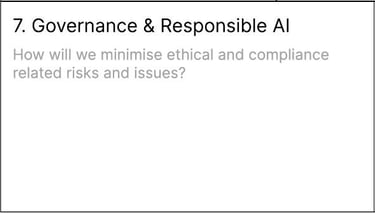

Section 8: Cost Structure & Financial Management
Purpose: To plan, measure, and optimise the costs associated with AI, which often follow a different pattern ("zig-zag costs") than traditional IT projects.
Key Questions to ask:
What are the key cost drivers of our AI initiatives (e.g., compute, data storage, talent, model licensing)?
How will we manage and optimise the cost of compute, especially for training and inference?
What is our FinOps strategy for AI to ensure we are managing cloud costs effectively?
How do we estimate the Total Cost of Ownership (TCO) for AI projects, including often-underestimated maintenance costs?
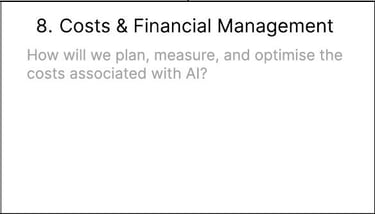

Section 9: Success Metrics & ROI
Purpose: To define and measure success to ensure AI initiatives deliver tangible value and justify investment.
Key Questions to ask:
What are the Key Performance Indicators (KPIs) for our AI initiatives? How do they link back to business outcomes?
How will we measure both financial ROI (e.g., cost savings, revenue increase) and non-financial benefits (e.g., employee satisfaction, customer experience)?
What is our process for tracking the value delivered by AI models post-deployment?
How will we define success across efficiency, effectiveness, and user experience (the "3Es")?
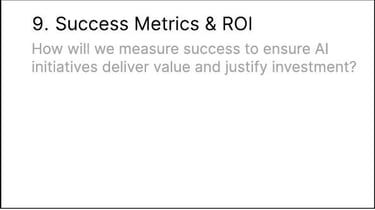

Business perspective: This viewpoint ensures that investments in artificial intelligence drive forward organisational digital transformation goals and strategic objectives. Specifically, numerous elements within this viewpoint demonstrate how to position AI as a central priority, mitigate potential risks, and amplify results and value for customers, thereby facilitating the development of a comprehensive AI strategy. Typical stakeholders encompass the Chief Executive Officer (CEO), Chief Financial Officer (CFO), Chief Operations Officer (COO), Chief Information Officer (CIO), and Chief Technology Officer (CTO).
People perspective: This viewpoint acts as a connection point between artificial intelligence technology and organisational operations, aiming to foster a culture of continuous development and knowledge acquisition, where transformation becomes standard practice. The framework expands by focusing on elements that most significantly influence future market competitiveness in the artificial intelligence era: appropriate talent, effective communication methods, and the organisational culture supporting them. Typical stakeholders encompass the Chief Human Resources Officer (CHRO), CIO, COO, CTO, and various other cross-functional organisation-wide leaders.
Governance perspective: This viewpoint enables organisations to coordinate artificial intelligence programs while optimising organisational advantages and minimising risks associated with transformation. Particular emphasis is placed on the evolving characteristics of risk and consequently the expenses linked to both creating and expanding AI solutions. Furthermore, a new element is incorporated into this viewpoint: The ethical application of AI. Typical stakeholders encompass the Chief Transformation Officer, CIO, CTO, CFO, Chief Data Officer (CDO), and Chief Risk Officer (CRO).
Platform perspective: This viewpoint enables organisations to construct an enterprise-level, expandable, cloud infrastructure that empowers them to both run AI-enhanced or integrated services and products, while also providing the capacity to create innovative and customised AI solutions. Enhanced elements illuminate how AI creation differs from conventional development activities and how professionals can adjust to that transformation. Typical stakeholders encompass CTO, technology leaders, ML operations engineers, and data scientists.
Security perspective: This viewpoint enables organisations to maintain the confidentiality, integrity, and availability of information and cloud operations. Best practices are leveraged while expanding on how organisations can evaluate the threat vectors that can impact AI systems and how to mitigate them through the cloud. Typical stakeholders encompass Chief Information Security Officer (CISO), chief compliance officer (CCO), internal audit leaders, and security architects and engineers.
Operations perspective: This viewpoint ensures that cloud services, particularly AI operations, are executed at a standard that satisfies organisational requirements. Guidance is offered on how to oversee operational AI operations, how to maintain their functionality, and how to guarantee consistent value generation. Typical stakeholders encompass infrastructure and operations leaders, ML operations engineers, site reliability engineers, and information technology service managers.
Framework for AI Adoption - 6 Perspectives












Strategy management
Create new business value through application of Artificial Intelligence (AI) and Machine Learning (ML).
Machine Learning facilitates innovative value propositions that subsequently drive enhanced business results, including minimised business risk, increased revenue, operational effectiveness, and strengthened ESG performance. Organisations should begin by establishing a business- and customer-focused vision for AI implementation and support it with a practical strategy that progresses incrementally toward integrating AI technology. Any implementation strategy must be grounded in concrete (short term and quantifiable) or ambitious (long term and challenging to quantify) business value that leverages these emerging capabilities. Both immediate and future implications of implementing AI should be incorporated.
Organisations should begin with current business and customer challenges and the impact that AI can deliver on them. When approaching the prioritisation of AI initiatives, determine how and which data will power the system's performance. Evaluate from the outset the self-reinforcing characteristics of a data flywheel on any ML product or service, where additional data generates an enhanced system that expands the customer base, multiplying the amount of data the organisation leverages.
During the construction of such a flywheel, evaluate if the data obtained can establish a defensive barrier around the value proposition (something that is scarce and expensive). Considering the extensive influence AI technology currently exerts on the competitive environment, customers will likely elevate their expectations regarding product and service performance in the coming period and AI capabilities represent a component of that expectation.
For each initiative, determine if the requirement is to build, customise, or implement an existing AI system. For instance, if the intention is to leverage the broad emergent capabilities of foundation models but organisational capabilities to develop them from scratch are absent, prioritise adapting them for specific requirements. If the goal is to develop a domain-specific general system to accelerate the business, allocate resources to the data foundations.
6 Organisation Capabilities Enhanced by AI


Product management
Manage data-driven and AI infused or enabled products.
Developing and managing AI-based products presents substantial challenges as the development and lifecycle of AI systems differs from traditional software and cloud products. Both the development and the operation and continuous generation of results (such as direct predictions) of any AI-based product involve potentially expensive uncertainties that demand specific mitigation strategies.
When developing or embedding AI into products, organisations should begin with customers' and users' anticipated value gain, and align measurable business proxies to individual decision points that an AI system can support, enrich, or automate. For each decision point, potential metrics should be defined in the ML solution domain (such as how the value gain of detecting fraudulent transactions in the financial sector translates to anticipated monetary gain and a correlating precision or recall of an ML-enabled transaction classifier) and the corresponding ML problem (such as a classification problem, an intent extraction problem, generative AI and many more). Together, these formulated ML problems and their individual solutions constitute the value-gain that ML delivers to the product.
Critically, these ML solutions impose certain data requirements on organisations and their products, hence the 4 V's of Data must be investigated for each of them. While building this knowledge bottom up, business, data, executive, and ML stakeholders must be involved in the assessment of the solution. Since ML products fuse data, domain, and technology into one predictive and sometimes prescriptive system, all of them are essential. The path should be paved to evolve AI-based products through proper lifecycle management, considering how users interact with probability based output from AI-systems (such as gracefully fail when the confidence of the system is low) and evaluating the impact of the solution when adopted to ensure responsible AI use.
Understanding of which questions are critical to properly scope the ML capabilities of products should be condensed and product management capability for AI should be improved. This means, for example, taking an experimental, often time-bound approach to de-risking the ML component and considering from the beginning how learnings from these experiments translate into a production-grade system. Equally it means designing feedback loops into the information flow of the system (or explicitly preventing them). Over time, the broader organisation should be enabled to build new AI products, based on the output of other ML systems through technologies such as data mesh and data lake architectures and by establishing proper knowledge transfer between teams and product groups.


Business insights
The power of AI to answer ambiguous questions or predict from past data.
Business intelligence (BI), predominantly including descriptive and diagnostic analytics, is frequently where organisations begin their journey when preparing to utilise AI. However, beyond descriptive and diagnostic analytics, ML enables predictive and even prescriptive capabilities and together they constitute the AI journey. It is essential to acknowledge that the scope of analytical and BI units has been different from what is expected organisationally from AI-driven ones.
Currently, many organisations require subject matter experts (SMEs) to sift through insights and extract the cause for certain observations in the data (the why). However, using AI techniques, BI is beginning to augment these SMEs and provide them new insights to incorporate into their thought process by identifying the why and the what if. With this, data and AI suddenly becomes the catalyst for predictive decision making.
When preparing the transition of BI practice to an AI-enabled one, and to higher level analytics in general, an effective way to push the boundaries is using algorithms with diagnostic analytics to help understand key variables or root causes influencing the problem statement. Organisational maturity in analytics should not be siloed with each subsection of the organisation and consideration should be given to how more mature organisations can cross-pollinate with the less mature to accelerate the AI journey.
In the early stages of transformation, an effective method can be creating a center of excellence for analytics (not necessarily AI) that is closely tied to cloud initiatives. Such a center of excellence (COE) can provide immediate value through democratised access to data-driven predictions and analysis and propel larger ambitions. Most importantly, creating a rhythm of using AI to inform major business decisions will drive the recognition of its value to a true business outcome.
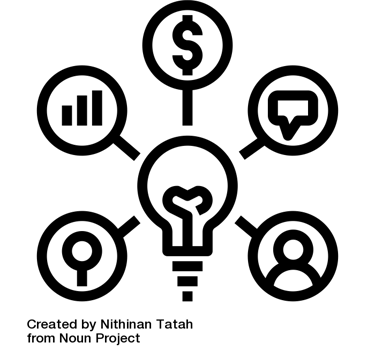

Portfolio management
Identify and prioritise high-value AI products and initiatives that are feasible.
The challenge of ML initiatives is that short-term results must be demonstrated without compromising long-term value. In the worst case, short-term thinking can result in technical AI proofs of concept (POCs) that never progress beyond that technical stage because they were concentrated on irrelevant business technicalities. The first goal when identifying, prioritising, and executing ML projects and products must be to deliver on tangible business results.
Beginning somewhere is essential, and small wins can generate confidence in the organisation as it helps people understand where they could apply AI in other portions of the business. At the same time, consideration should be given to what larger customer and business problems are being solved through multiple AI projects and products and combining those into a hierarchical portfolio where the lower layers of that portfolio support the upper layers. Certain AI capabilities simply cannot be built in one go. Rather, they build upon each other. For example, in the financial industry, before being able to recommend new products to customers, the ability to categorise what is important today must exist, so classifying transactions precedes next-best-offer actions. Each layer of the portfolio should add additional value to the organisation at large.
Next, embedded in this portfolio should be the design of an AI flywheel where the value that the portfolio provides propels business outcomes that, in turn, enable and create additional data from which the portfolio benefits (see Figure 6). This flywheel does not need to be on a single-product level but can extend through the portfolio. As the portfolio evolves and scales, prioritising what to buy versus what to build becomes essential. Pushback on the not invented here syndrome is necessary.
Exploring which use cases and which solutions already exist in the market, and at what maturity level, should not be an afterthought. Also investigation is needed into which solutions require custom modeling, and the AI workforce's efficiency should be raised by choosing the right AI products and cloud environment. Recognition is needed of how complex it is to even just technically govern the portfolio. To ensure the scarce AI workforce remains efficient, decisiveness and boldness are required, and pushback on analysis paralysis is necessary.


Innovation management
Question long-standing market hypothesis and innovate your current business.
ML offers new capabilities to businesses that can be and in many cases are disruptive to existing businesses and value chains. The power of this general-purpose technology is observed and experienced across sectors and there is virtually no exception to that, as the long-term objective of AI-research is to replicate or at least imitate intelligence. The historically human capability to perform knowledge work and process complex information, reason and derive insights, and take actions can now be addressed by advanced foundation models and generative AI. In the innovation roadmap and the innovation management practice, connections should be made to these mid- and long-term objectives of AI research through short-term and real-world applicable value propositions.
To accomplish this, organisations should begin by exploring the evolving customer expectations and needs, both from an internal and external perspective. The business outcomes that AI frameworks suggest can guide the identification of these needs and expectations. Consideration should be given to the value chain of ML-enabled or infused products, and differentiation between innovation for cost reductions (such as process improvements), revenue and profit gains (such as product improvements), or completely new income channels (such as new products and services).
ML should be used and positioned as a unique differentiator to the respective internal and external stakeholders, and customers. ML should be integrated to unlock new capabilities, augment existing ones, and reduce effort through automation. Organisations should capitalise and double down on domain-specific knowledge that is represented in the data they access. A healthy data value chain should be designed for AI systems to allow long-lasting value generation. Discouragement should be avoided that some ML-based products only grow better over time, or that innovation cycles might be longer than what some companies are accustomed to. While building up single lines of ML-enabled products, the way should be paved to innovation across the organisation by raising data to a first-class citizen of the value-creation process and creating internal data products for consumption.
Additionally, to this top-down approach to innovation-management, a grassroots movement should be established through internal AI champions. These champions can be business owners, product managers, technical experts, as well as the C-suite. A constant balance between audacious goals and the achievable ones should be maintained. While typical software systems and environments grow their value with an increasing number of users, the value of ML systems is driven largely by the data that makes it more effective. Therefore, managing AI innovation also means bringing the data strategy to life, not just archiving data that describes the past. With this growing high-quality and value data that is governed and accessible across organisational boundaries, gravity will be created for AI ideas and projects.


Generative AI
Use the general-purpose capabilities of large AI models.
The primary aim of AI is to develop systems that possess general quality and can be deployed across numerous complex problem domains with minimal to no additional expense. One exceptionally powerful branch of this field is generative AI, a form of AI that can generate new content and concepts, including conversations, stories, images, videos, and music. Generative AI is driven by very large models that are pre-trained on extensive volumes of data known as "Foundation Models" (FM). The promise of these FMs resides in their ability to generalise across domains and tasks. Such foundation models will, in one form or another, impact organisations and businesses as they substantially decrease the expense of knowledge work. When strategising to implement this powerful category of AI, there are three considerations. Organisations must assess if they need to develop such FMs:
From the ground up and uniquely customised to the business?
Refine a pre-trained model and leverage on the competencies it has already acquired?
Deploy an existing product from a vendor without additional refinement?
Possessing the option between these three is critical and the appropriate choice hinges on the business case. Very often extracting the genuine value of these large models involves contextualising them with domain specific data and deploying them to a wide spectrum of tasks. This occurs because large and pre-trained models already contain emergent competencies (for example, reasoning) that are expensive to generate from the ground up. Therefore, when deploying foundation models and generative AI, organisations should leverage on a pre-trained model's capacity to adapt and learn from minimal to no data.
For many enterprises, this methodology involves identifying the appropriate foundation model for their business challenges and tailoring (for example, through instruction tuning and few-shot learning) and refining them with domain- or customer-specific data. The performance and differentiating competencies of generative AI and foundation models, just as with other AI systems, will predominantly depend on the data strategy and data flywheel. Whichever direction is selected, confirmation is required that confidence exists with the data utilised, as the data determines how the model will perform in production, and implementing guardrails around generative AI systems is considerably challenging.


Excellence in consulting
Incremental Excellence are experts for all your Artificial Intelligence solution and adoption needs.
© 2025. All rights reserved.
Subscribe to our newsletter, and we will keep you informed about Enterprise AI and new technologies and how they impact you.
Enter your email below and press "Subscribe"

